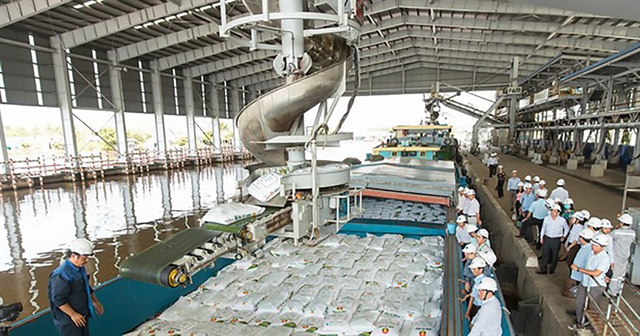 Economy
Economy

Falling selling prices and rising costs have caused the profits of most fertiliser businesses to plunge, after recording high profits in the previous few years.

|
| Fertiliser products of Petro Việt Nam Cà Mau Fertilizer JSC (DCM) being processed. In Q1 this year, DCM recorded a 33 per cent decrease in revenue and a 85 per cent decrease in profit after tax compared to the same period in 2022. Photo DCM |
HÀ NỘI — Falling selling prices and rising costs have caused the profits of most fertiliser businesses to plunge, after recording high profits in the previous few years.
Urea prices down 30-40 per cent
Fertiliser prices have fallen sharply since the fourth quarter of 2022.
Profits of the fertiliser businesses in the fourth quarter of 2022 decreased deeply, with some companies even recording losses, although the profits in the whole year 2022 still grew at high rates.
Plunging profits continued in the first quarter of 2023.
In Q1 this year, PetroVietnam Cà Mau Fertiliser Joint Stock Company (DCM) recorded a 33 per cent decrease in revenue and an 85 per cent decrease in profit after tax compared to the same period in 2022, to reach VNĐ2.73 trillion and VNĐ229 billion, respectively. This was the lowest profit in the last seven quarters.
According to DCM, the average selling prices of urea in the first quarter of 2023 decreased by more than 32 per cent year-on-year, and the increase in selling expenses were the two main reasons for the decline in profits.
At the end of the first quarter of 2023, PetroVietnam Fertiliser and Chemicals Corporation (DPM) recorded revenue of VNĐ3.29 trillion, down 44 per cent; profit after tax reached VNĐ262 billion, down 87.6 per cent year-on-year.
DPM said that in the first quarter of 2023, the output of fertiliser trading products decreased, especially the selling price of urea decreased by 44 per cent. Besides, the higher gas prices in the same period led to a decrease in the sales of commodities, which resulted in a corresponding fall in profits (gas accounts for a large proportion of the cost of producing ammonia, a key raw material for fertiliser production).
Bình Điền Fertiliser Joint Stock Company (BFC) lost more than VNĐ39 billion in the first quarter of 2023, while revenue decreased by 48 per cent over the same period last year, reaching only VNĐ1.36 trillion.
BFC said that in the first quarter of 2023, the company actively reduced selling prices, making gross profits decrease by more than 73 per cent; sales volume fell by more than 85,000 tonnes, equivalent to a drop of 52 per cent over the same period last year. This led to a deep fall in profits, although the company actively reduced administrative expenses and selling expenses, respectively, by 51 per cent and 44 per cent.
General Director of BFC Ngô Văn Đồng said that in the first quarter of 2023, fertiliser prices fell sharply and quickly, so fertiliser agents only ordered fertiliser products according to actual consumption needs, not storing products in warehouses as before. Therefore, the company's output and selling price did not meet expectations.
Việt Nam's fertiliser exports from the beginning of 2023 have been under strong competitive pressure as the supply from Russia and China increases. According to the General Department of Customs, in the first four months of 2023, Việt Nam exported over 537,200 tonnes of fertiliser, bringing in US$232.16 million, down 17 per cent in volume and 43.6 per cent in value over the same period of 2022.
The decrease in demand and the increase in inventories led to a sharp drop in domestic urea prices. Urea prices in April and May 2023 decreased by 30-40 per cent over the same period last year.
Careful plan
MB Securities (MBS) said that the policy of restricting the export of fertilisers of Russia and China has been relaxed or is about to expire, causing an increase in fertiliser supply and a decrease in fertiliser prices. Fertiliser prices may decrease and world oil prices also tend to correct.
In that context, fertiliser manufacturing and trading companies have cautiously planned their business for 2023.
Hà Bắc Fertilisers and Chemicals Joint Stock Company (DHB) expects that in 2023, revenue will reach VNĐ4.6 trillion, profit after tax will total VNĐ931 billion, down 28 per cent and 47.6 per cent respectively compared to the performance in 2022.
DPM expects to achieve revenue of VNĐ17.3 trillion in 2023, profit after tax of VNĐ2.25 trillion, down 8.6 per cent and nearly 60 per cent respectively compared to the level in 2022. Considering that market demand tends to decrease, DPM's Phý Mỹ Fertiliser plant plans to reduce production output to balance consumption capacity.
MBS predicts that DPM's business results in 2023 may not meet its plan, likely to achieve revenue of only VNĐ15.12 billion, profit after tax of VNĐ2.18 trillion.
Bình Điền Fertiliser plans to achieve revenue of VNĐ7.48 trillion, profit before tax of VNĐ220 billion, down 12 per cent in revenue but up 18.5 per cent in profit compared to last year's performance.
Analysts say that fertiliser prices will continue to decline in the first months of 2023, but will soon stabilise again due to reduced inventories and increased demand for soil nutrients. When fertiliser prices fall, farmers will buy more fertilisers to supplement soil nutrients after a limited period because of high prices in the previous two years. VNS